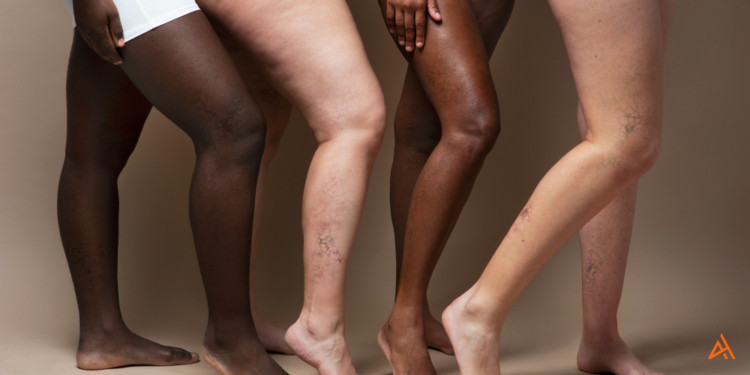Cellulite is a common concern for many individuals, often associated with the desire to maintain a healthy body weight and appearance.

Despite the allure of quick fixes like liposuction and laser treatments, these methods frequently fail to deliver the desired results. In fact, according to the American Society of Plastic Surgeons (ASPS), liposuction is notably ineffective in treating cellulite or loose skin.
What is Cellulite?
Cellulite manifests as a bumpy or dimpled texture on the skin, often compared to the appearance of cottage cheese or orange peel. It predominantly affects areas like the thighs, buttocks, stomach, and arms. The condition arises when fat deposits push against the connective tissue beneath the skin, creating an uneven surface. While cellulite can develop at any age, it tends to worsen with age and weight gain, primarily affecting women.
Causes of Cellulite
Understanding the underlying causes of cellulite is key to managing it effectively. Here are the primary factors:
Weak Collagen Structure:
As we age, collagen production decreases, leading to reduced skin thickness and elasticity. This weakened structure can exacerbate the appearance of cellulite.
Genetic Predisposition:
Genetics play a significant role in determining how prone an individual is to developing cellulite. Certain genetic factors influence skin structure, fat distribution, and circulation, all of which contribute to cellulite formation.
Dietary Habits:
Poor diet, fluid retention, and dehydration can worsen cellulite. A diet high in salt, sugar, and processed foods can lead to inflammation and fat accumulation, increasing the visibility of cellulite.
Lifestyle Factors:
A sedentary lifestyle, poor circulation, and hormonal imbalances can also contribute to the development of cellulite. Regular physical activity and maintaining hormonal balance are essential for minimizing its appearance.
Other Influences:
Stress, smoking, and excessive sun exposure can negatively impact skin health, leading to the development or worsening of cellulite.
How to Manage and Reduce Cellulite
While eliminating cellulite entirely may be challenging, a comprehensive approach can significantly reduce its appearance. Here’s how:
1. Dietary Adjustments
Reduce Salt Intake:
High salt intake can cause fluid retention, worsening cellulite. Season food with herbs and spices instead of salt.
Incorporate Detoxifying Foods:
Include foods like spinach, tomatoes, and citrus fruits in your diet to help detoxify the body and reduce fluid retention.
Focus on Antioxidants and Omega-3 Fatty Acids:
Foods rich in antioxidants and omega-3s, such as berries, nuts, and fatty fish, support skin health and reduce inflammation.
Hydration:
Drink at least 2 liters of water daily to keep the skin hydrated and flush out toxins. Green tea can also be beneficial for its detoxifying properties.
Regular Exercise
Aerobic Activities:
Engage in activities like brisk walking, running, or cycling to burn calories and reduce fat accumulation.
Strength Training:
Incorporate weight training exercises that target the legs and glutes to tone muscles and improve skin texture.
3. Lymphatic Drainage
Manual Techniques:
Daily lymphatic drainage massages can help reduce fluid buildup and improve circulation, leading to a reduction in cellulite.
Specialized Devices:
Consider using devices like pressotherapy or mechanical lymphatic drainage systems to enhance the effects of manual techniques.
4. Cosmetic Procedures
Targeted Treatments:
While lifestyle changes are crucial, cosmetic procedures like radiofrequency treatments can complement these efforts by targeting localized fat deposits. Always consult with a dermatologist or cosmetic professional to determine the most appropriate treatment based on your individual needs.
Can Cellulite Be Eliminated?
While completely eliminating cellulite may not always be possible, it can be significantly managed and reduced through a combination of dietary adjustments, regular exercise, and targeted treatments. For optimal results, consult with a healthcare professional to develop a personalized plan.
Understanding the Risks
Although cellulite is often viewed as a cosmetic issue, it can sometimes signal underlying health problems like poor circulation or fluid retention. If cellulite becomes more pronounced despite treatment, it may indicate a vascular issue, necessitating professional evaluation by a dermatologist.
Conclusion
Cellulite, characterized by its lumpy texture resembling orange peel or cottage cheese, results from a combination of factors such as poor diet, inadequate circulation, and weakened collagen structures. While quick fixes like liposuction and laser therapy are tempting, they often fall short in delivering long-term results. A more effective approach involves maintaining a healthy body weight, engaging in regular exercise, and making dietary adjustments. Additionally, treatments like collagen supplementation, adequate hydration, and the use of natural metabolic support supplements can further aid in managing cellulite.
FAQs
- Can cellulite be eliminated?
- While complete elimination isn’t always possible, lifestyle changes and professional interventions can effectively reduce its appearance.
- Are cosmetic procedures necessary to reduce cellulite?
- Cosmetic procedures can complement natural methods by targeting specific areas but are not essential for cellulite management.
- How long does it take to see results from cellulite treatments?
- Results vary depending on individual factors like skin type and genetics, but consistent treatment can lead to noticeable improvements over time.
- Are there any risks associated with cellulite treatments?
- While most treatments are safe, some may carry risks such as bruising, swelling, or infection. Consulting with a qualified professional is crucial.
- Can cellulite worsen with age?
- Yes, as skin elasticity decreases and fat deposits increase, cellulite can become more pronounced with age. However, healthy habits can help mitigate its progression.
By adopting a holistic approach to managing cellulite, individuals can achieve significant improvements in the appearance of their skin, boosting confidence and overall well-being.
Do you wish to initiate a DMCA takedown report? Kindly send details to [email protected] or [email protected]
Written: ( 01:15 am)









